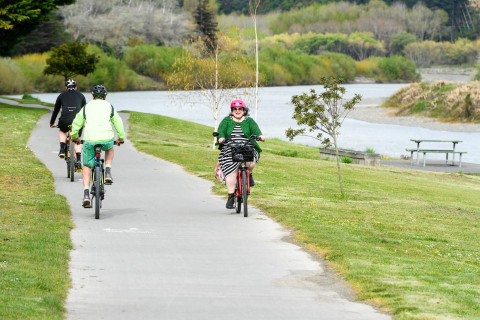
Each region of New Zealand is required to maintain a 10-year transport plan, called the Regional Land Transport Plan or RLTP. These cover all aspects of transport planning and spending – walking, cycling, public transport – and oh yes, road construction and maintencance (nearly forgot).
Most councils undertake a lot of public engagement and consulting, although the way they do this varies around the country. In one extreme, you’re just dumped into a baffling 100+ page document and have to do your best; in the other, there’s a friendly questionaire with simple options to choose from – but these options might not be a true reflection of what is at stake. It’s all a bit of a minefield.
Things are even more confusing this year as the Government has just released a draft Government Policy Statement (GPS) on transport, with submissions due by 12pm on 2 April 2024. The RLTPs have to be consistent with the GPS, which means that councils may have to revise their plans further, possibly with extra consultation.
Depending on where they are in their planning cycle, councils will either be making entirely new 10-year plans, or reviewing the plans already underway.
By my reckoning, Northland, Bay of Plenty, Hawkes Bay, Taranaki, Manawatū-Whanganui, West Coast, and Otago-Southland all have RLTPs out for public comment at the moment, with submissions due in a week or two. Auckland and Wellington have been waiting for the new GPS – their new plans should be out very soon.
What to watch out for: climate action and effective cycling plans
The RLTPs often talk a good talk on climate but do not deliver. Some of them are given a “Climate Assessment of Transport Investment” (CATI) score, which can range from –3 (tends to increase emissions) to +3 (tends to reduce emissions). In my region, Manawatū, the CATI score is –0.62 – a slight increase in emissions. Not at all adequate, considering that one of the plan’s headline targets is for a “30% reduction in regional carbon emissions from land transport by 2030”. But also not surprising, since most of the money goes towards roads.
Again in my region, $100 million is allocated towards walking and cycling between now and 2031. It sounds like a lot, but it’s only 2% of the $5 billion total spend. The UN recommended in 2016 that at least 20% of total transport spending should be for non-motorised travel. Really, it should be much more than that, at least until we’ve caught up on decades of under-investment.
However, of this $100 million:
- $10 million is for NZTA for state highways, who have failed to deliver past cycling projects, spending only 7% of their cycling budget in 2023 and the Levin-Foxton and Longburn-Rangiotu cycleways deferred, Ohakea-Bulls delayed, Raurimu-Horopito reviewed, and Warrengate-Whangaehu and Te Matai Road-Raukawa Road cancelled.
- $37 million is for a clip-on cycling bridge on SH3 at Ashhurst, which will connect to the cycling path alongside the new road over the Ruahine Ranges that is being built to replace the Manawatū Gorge road, which has been closed since 2017. A clip-on for lightweight vehicles is costing three times as much per kilometre as a 4-lane expressway with multiple bridges, trestles, and the deepest cuttings yet attempted in New Zealand. (If you can explain this, let me know.) Apart from the cost, my problem is that this clip-on will see almost entirely recreational use – it does not enable ‘transport choice’ in the normal sense of the phrase.
- $4m is for Mountains to Sea, again serving tourists and recreational users.
- $30m is for the Palmerston North-Feilding pathway. This could see a small amount of commuter use and displace some car trips, but no information about this is presented. The Feilding half of the cycleway has already been built at a cost of $1.2m, but the discrepancy is not explained.
So unfortunately, none of the proposed cycling projects will deliver the mode shift, driving reduction, or sustainability goals that the plan says are wanted. What is needed is work towards a complete, safe cycling network in each of our cities. This is what some New Zealand cities are working towards, but they need support to see their projects through.
My takeaway about RLTPs: they are a key part of our transport planning system. They are bureaucratic, but it’s worth investing a bit of time to dig into the actual projects under consideration and seeing if they stack up with the council’s avowed goals. And when in doubt, follow the money.
Regional Land Transport Plan consultations
Region | Plan duration | Status / Link | Deadline |
Northland | 2021-2027 | 15 March | |
Auckland | 2021-2031 | Delayed | Soon! |
Waikato | 2024-2054 | https://www.waikatoregion.govt.nz/council/policy-and-plans/transport-policy/draft-rltp-2024/ | 4 March |
Bay of Plenty | 2024-2034 | 24 March | |
Gisborne | 2021-2031 | 29 February | |
Hawkes Bay | 2021-2031 | ||
Taranaki | 2021-2027 | https://haveyoursay.trc.govt.nz/taranaki-regional-land-transport-plan | 16 March |
Manawatu-Whanganui | 2021-2031 | 11 March | |
Wellington | 2021-2031 | Delayed | Soon! |
Nelson-Tasman | 2024-2034 | 25 February | |
Marlborough | 2021-2031 | ||
Canterbury | 2024-2034 | https://haveyoursay.ecan.govt.nz/regional-land-transport-plan24 | 26 February |
West Coast | 2021-2031 | 28 March | |
Otago-Southland | 2021-2031 | 15 March |

Comments
Thanks
It's encouraging to see that some cities in New Zealand are actively working towards comprehensive cycling networks, but as you mentioned, they need adequate support to realize these projects fully. Hopefully, increased scrutiny and public engagement can help drive meaningful changes in future RLTPs to better reflect the priorities of communities and the imperative of addressing climate change. Cincinnati SEO company